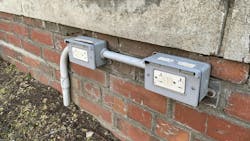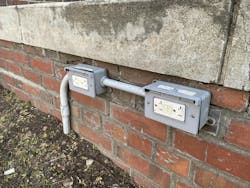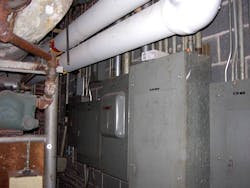What's Wrong Here? Hint: Parts Missing in Action
How well do you know the Code? Think you can spot violations the original installer either ignored or couldn’t identify? Here's your chance to moonlight as an electrical inspector and second-guess someone else's work from the safety of your living room or office. Can you identify the specific Code violation(s) in this photo? Note: Submitted comments must include specific references from the 2023 NEC.
Hint: Parts missing in action
Tell Them What They've Won…
Using the 2023 NEC, correctly identify the Code violation(s) in this month's photo — in 200 words or less — and you could win a $25 Amazon gift card. E-mail your response, including your name and mailing address, to [email protected], and Russ will select one winner (excluding manufacturers and prior winners) at random from the correct submissions. Note that submissions without an address will not be eligible to win.
May Winner
Our winner this month was EC&M reader Andrew Smith. He knew that the working space in front of the electrical equipment in this photo needs to be kept clear and unobstructed by pipes, tanks, support racks and other obstructions.
Section 110.26(A) requires working spaces to comply with the dimensions specified in Sec. 110.26(A)(1),
(A)(2), (A)(3), and (A)(4). Table 110.26(A)(1) requires a minimum depth of 3 ft be kept clear in front of this electrical equipment. Section 110.26(A)(2) requires the width of the working space to be 30 in. minimum, or — in this case — as wide as the electrical equipment because it is wider than 30 in. Section 110.26(A)(3) requires the working space to provide a minimum height of 6½ ft or the height of the electrical equipment, whichever is higher.
For this installation, I would say that Sec. 110.26(A)(4) is not applicable because the electrical equipment was installed here before the plumbing pipes and other plumbing equipment was added after the initial electrical installation. While these violations were most likely not the fault of the electrician who originally installed the electrical equipment, they are still violations and certainly make it more dangerous to work on this electrical equipment while it is energized.
About the Author

Russ LeBlanc
Owner
Russ started in the electrical trade as an apprentice in 1985. He worked his way up to become a Journeyman Electrician and then eventually became a Master Electrician and Licensed Construction Supervisor. In 1999 Russ become an Electrical Instructor for The Peterson School of Engineering in Massachusetts where he developed his passion for teaching, and quickly became Department Head of Electrical Instruction. Russ has taught thousands of apprentices, electricians, engineers, inspectors, and other electrical professionals during his career as an instructor. He continues to provide electrical professionals with Electrical Code seminars, Arc-Flash Awareness training seminars and educational material through his LeBlanc Consulting Services in North Reading, MA whose specialty is educating electricians. He has been an active member of the NFPA Electrical Section and has authored hundreds of National Electrical Code proposals and comments which have become Code rules to improve the safety for the electrical industry. Russ is also an IAEI certified Electrical Inspector.
Please visit www.russleblanc.net for more information.


